
Die heutige Flagge des Sudan wurde am 20.05.1970 offiziell gehisst. Sie zeigt drei waagerechte Streifen in Rot, Weiß und Schwarz und ein gleichschenkliges grünes Dreieck am Mast. Die Farben der Flagge scheinen definiert worden zu sein, auch im HEX-Farbraum: Grün = HEX #007229, was Pantone 356 entsprechen würde, Rot = HEX #D21034, was Pantone 186 entsprechen würde. Die Farben des blau-gelb-grünen Vorgängermodells scheinen ebenfalls definiert, auch im HEX-Farbraum, was verwunderlich ist, für eine Flagge der 50-er und 60er Jahre des 20. Jahrhunderts: Blau = HEX #0F47AF, was Pantone 293 entsprechen würde, Gelb = HEX #FFF500, was Pantone 803 entsprechen würde, Grün = HEX #00923F, was Pantone 355 entsprechen würde.
Zu Bedeutung oder Ursprung der Farben gibt es mehrere Erklärungsvarianten:
• Rot symbolisiert Fortschritt, Revolution und das Blut der Patrioten, Weiß Friedensliebe und Schwarz das Land selbst ("Sudan" bedeutet "Schwarz"). Das Grün des Dreiecks am Mast ist die Farbe des Islam, gilt aber auch als Symbol des Gedeihens.
• Rot steht für Sozialismus, Weiß für Reinheit und Optimismus und Grün für Wohlstand. Schwarz steht wieder für das Land selbst ("Sudan" = "Schwarz").
• Die Farben sind diejenigen der Umma-Partei, eine der ältesten und einflussreichsten Parteien des Landes, die sich als Nachfolgerin der Mahdi-Bewegung betrachtet, mittlerweile jedoch in der Illegalität wirkt.
• Der Farbenvierklang von Grün, Weiß, Schwarz und Rot ist ein speziell arabisches Farbsymbol, die Panarabischen Farben. Die (pan)arabischen Farben wurden während des 1. Weltkriegs, bei der Loslösung des Königreichs Hedschas vom Osmanischen Reich, durch den Scherifen Hussein von Mekka – aus dem Geschlecht der Haschemiden – als Farben der Arabischen Bewegung offiziell eingeführt. Als Vorlage diente die Flagge des Hedschas. Die Farben haben folgende Bedeutung: Rot ist die Farbe von Omar, dem zweiten Kalifen; Weiß steht für die Omajiaden, eine Kalifendynastie, die auf den fünften Kalifen Moawija I. zurückgeht; Grün steht für die Fatimiden, eine ismailitisch-schiitische Kalifendynastie, die auf den vierten Kalifen Ali zurückgeht; und Schwarz steht für die Abbasiden, eine Kalifendynastie, die auf den Kalifen Abbas I. zurückgeht. Rot ist außerdem die Farbe der Haschemiden, eine arabische Herrscherdynastie, die wahrscheinlich auf Haschim ibn Abd al-Manaf, den Großvater Mohammeds, zurückgeht. Grün ist außerdem die Farbe des Islam im Allgemeinen, und bezieht sich somit nicht nur auf die arabischen Länder.
• Die Farbgebung der Flagge leitet sich von der Flagge Ägyptens ab, da sie weitgehend der 1952 von Nasser eingeführten arabischen Befreiungsflagge ähnelt.
Die 1956 bei Erlangung der Unabhängigkeit angenommene Flagge war blau-gelb-grün waagerecht gestreift, wurde jedoch im Zusammenhang mit der Gründung der Demokratischen Republik am 25.05.1969 abgeschafft. Nach einer Ausschreibung wurde am 20.05.1970 die heutige Flagge angenommen. Die Flaggen der Luftwaffe und der Marine sind insofern bemerkenswert, weil sie als einzige Flaggen des Landes bis heute dem britischen Ensign-System folgen. Von einer schwarz-weiß-schwarzen Flagge der Streitkräfte wird berichtet. Die Präsidentenflagge hat dasselbe Aussehen wie die Nationalflagge, trägt jedoch in der Mitte des weißen Streifens das Wappen des Landes in Gold. Das Gebiet des heutigen Sudan und Südsudan wurde ab 1820 nach und nach von Ägypten erobert, wobei der Vizekönig immer noch der Hohen Pforte des Osmanischen Reiches unterstand, das blieb bis 1914 so. Mit dem beginn des Ersten Weltkriegs wurde dieses Unterstellungsverhältnis abgeschafft. Sich zeitlich überschneidend war Ägypten von 1882 von britischen Truppen besetzt worden, was 1899 in einer gemeinsamen Verwaltung des Sudan, als Anglo-Ägyptischer Sudan, gipfelte. Bis zur Unabhängigkeit wurden immer zwei Flaggen aufgezogen, die britische Flagge und die jeweilige ägyptische Flagge.
Quelle: Die Welt der Flaggen,
Wappen und Flaggen aller Nationen,
Flaggen Wappen Hymnen,
Flaggen-Atlas Erde,
Wikipedia (EN),
Volker Preuß

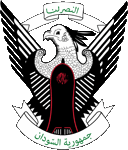
seit 1970,
Wappen von Sudan,
Quelle, nach: Corel Draw 4

Das heutige Staatswappen wurde 1970 eingeführt. Es zeigt einen Sekretär (afrikanischer Greifvogel), den Nationalvogel des Sudan. Er trägt auf der Brust einen Eingeborenenschild. Oberhalb des Vogels ein Spruchband mit dem Motto des Staates in Arabisch: "Al Nasr nila" → "Der Sieg ist unser". Auf den unteren Spruchband steht der Name des Landes, ebenfalls in Arabisch.
Quelle: Flaggen Wappen Hymnen


1956–1970,
Flugzeugkokarde,
Quelle, nach: Wikipedia (EN)

seit 1970,
Flugzeugkokarde,
Quelle, nach: Wikipedia (EN)

Lage:
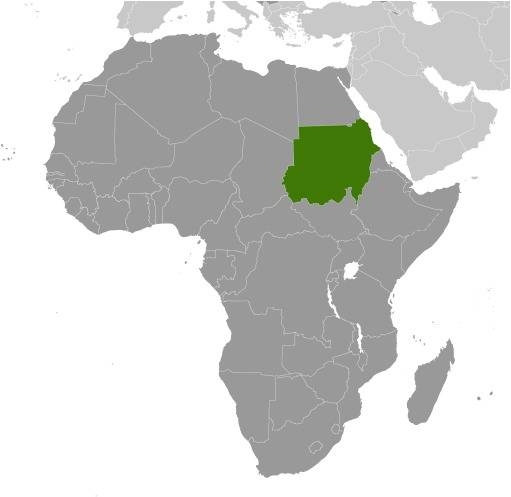
Quelle/Source: CIA World Factbook
Landkarte des Landes:
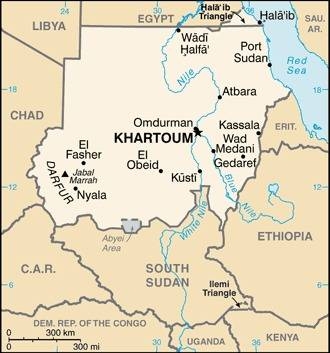
Quelle/Source: CIA World Factbook
interaktive Landkarte des Sudan:
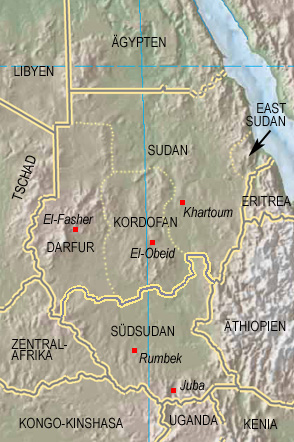
Quelle/Source: Freeware, University of Texas Libraries,
modyfied by: Volker Preuß

Fläche: 1.861.484 km²
Einwohner: 49.200.000 (2023), davon 70% Araber, 30% Fur, Beja, Nuba, ...
Religionen: größtenteils Moslems, einige Christen
Bevölkerungsdichte: 26 Ew./km²
Hauptstadt: Khartoum (Khartum, al-Chartum), 2.682.431 Ew. (2012)
Amtssprachen: Arabisch, Englisch
sonstige Sprachen: Sudanarabisch, nilotische Sprachen, etc.
Währung: 1 Sudanesisches Pfund (£S, sud£, SDG) = 100 Piaster (Quirsh)
Zeitzone: MEZ + 1 h
Quelle: Wikipedia (D),
CIA World Factbook

3500 v.Chr. · Nubisches Reich Kusch im Norden des heutigen Sudan
2600 v.Chr. – 1070 v.Chr. · der Norden des heutigen Sudan gehört zu Ägypten
300 v.Chr. – 300 n.Chr. · Nubisches Reich Meroë im Norden des heutigen Sudan
350 n.Chr. · Meroë zerfällt in drei Königreiche (Nobatia, Mukurra, Alwa)
600 · Nubien bekennt sich zum koptischen Christentum, in den Folgejahren islamische Attacken
1315 · Mukurra bricht unter dem Arabischen Ansturm zusammen
1504 · Alwa bricht unter dem Arabischen Ansturm zusammen
ca. 1500 – 1700 · Reich der Fundsch im südlichen Sudan, der Norden wird von den ägyptischen Mameluken abhängig
ca. 1620 · Darfur wird islamisiert
1805 · der albanische Offizier Muhammad Ali Pascha ergreift in Ägypten die Macht und installiert seine Dynastie, zunächst als Gouverneur, ab 1867 als Vizekönig (Khedive) im Auftrag der Hohen Pforte des Osmanischen Reiches
1820–1821 · Mohammed Ali von Ägypten erobert den Nordsudan (Nubien und Kordofan)
1823 · Gründung von Khartum durch die Ägypter
1863–1875 · Ismail Pasha von Ägypten erobert teilweise den Südsudan und Darfur (1874)
1875–1881 · die Ägypter versuchen den Sklavenhandel zu unterbinden
1881–1898 · antiägyptisch-klerikaler Mahdiaufstand unter der Führung des Mohammed Achmed, genannt Mahdi, Bildung des Mahdireiches
1882 · Großbritannien besetzt Ägypten
1885 · Tod des Mahdi, Nachfolger wird Chalifa Abdullahi
1888–1889 · das Mahdireich attackiert Äthiopien und erobert den Südsudan
1896 · Lord Kitchener, der britische Oberkommandierende der ägyptischen Armee, erhält den Auftrag gegen das Mahdireich vorzugehen
1898 · Schlacht von Omdurman, Lord Kitchener vernichtet das Mahdireich
1898 · Schlacht von Faschoda, Lord Kitchener schlägt in den Südsudan eingedrungene Franzosen zurück
1899 · der Sudan wird offiziell von Ägypten und Großbritannien gemeinsam verwaltet (Anglo-Ägyptischer Sudan)
1914 · in Ägypten wird das Osmanische Vizekönigreich abgeschafft, die Oberhoheit des Osmanischen Reiches endet, Proklamation des britischen Protektorats Sultanat Ägypten
1924 · britische Versuche den Norden und Süden des Sudan getrennt zu verwalten
1948 · erste Wahlen zu einer gesetzgebenden Versammlung
22.10.1952 · Ägypten und Großbritannien gewähren dem Sudan innere Selbstverwaltung
1955 · der christliche und animistische Südsudan befürchtet in einem unabhängigen Sudan eine nördliche islamische Dominanz und beginnt den zunächst 17 Jahre andauernden Bürgerkrieg
01.01.1956 · Ägypten und Großbritannien gewähren dem Sudan Unabhängigkeit, Republik Sudan
1958 · Militärputsch von General Ibrahim Abboud, Auflösung des Parlaments
1964 · General Abboud setzt eine Zivilregierung ein
1969 · Militärputsch von Muhammad Gaafur al-Numeiri, Auflösung des Parlaments, Verbot aller Parteien, Proklamation der Demokratischen Republik Sudan
1971 · kommunistischer Putschversuch scheitert
1972 · Abkommen von Addis-Abeba zwischen der Regierung des Sudan und der südsudanesischen Befreiungsfront, vorläufiges Ende des Bürgerkriegs im Süden, Gewährung von Autonomie für den Südsudan
1973 · neue Verfassung
1975 · Putschversuch der Nationalen Front mit libyscher Unterstützung scheitert
1983 · der Südsudan wird in drei separate Regionen aufgeteilt, Einführung des islamischen Rechts, der Bürgerkrieg im Süden bricht erneut aus
1984 · Verkündung des Ausnahmezustands
1985 · Militärputsch von General Abdul Rahman Swaredahab, Proklamation der Republik Sudan
1986 · Proklamation der Islamischen Republik
1989 · Militärputsch
1992 · Offensive gegen den Südsudan
1994 · Offensive des Südsudan gegen Regierungstruppen
1994 · der Beja Congress im Ostsudan beginnt mit dem bewaffneten Kampf
1996 · Etablierung einer Zivilregierung mit beratendem Charakter, Isolierung des Südsudan
1997 · erfolgreiche Offensive der südsudanesischen SPLA (Sudanesische Volksbefreiungsarmee)
1998 · neue Verfassung
12.12.1999 · Verkündung des Ausnahmezustands, Auflösung des Parlaments
2003 · Ausbruch des Darfur-Konflikts, Afrikanische Rebellen nehmen den Kampf gegen die arabische Regierung des Sudan auf, Regierungstruppen und Milizen vertreiben 2,5 Millionen Einwohner, 400.000 sterben
2004 · Friedensabkommen zwischen Darfur und Sudan scheitert
2005 · Friedensabkommen mit dem Südsudan, Ende der Kämpfe, Autonomie für Südsudan
2006 · Waffenstillstand, Friedensabkommen mit dem Ostsudan
2008 · erneut Kämpfe zwischen Sudan und Südsudan
09.01.2011 · Beginn einer mehrtägigen Volksabstimmung zur Unabhängigkeit im Südsudan
09.07.2011 · der Südsudan erklärt seine Unabhängigkeit
2019 · Militärputsch, Ausnahmezustand
2021 · Militärputsch
2021 · Wiedereinsetzung einer zivilen Regierung
2022 · Aufhebung des Ausnahmezustands
2023 · Kämpfe zwischen den sudanesischen Streitkräften (SAF) und den Rapid Support Forces (RSF)
Quelle: Atlas zur Geschichte,
World Statesmen,
Wikipedia (EN),
Volker Preuß

Der Name des Sudan leitet sich von der arabischen Bezeichnung "Bilad es-Sudan" ab. Das heißt "Land der Schwarzen" und bezeichnet eigentlich die ganze Region zwischen Sahara und dem afrikanischen Regenwald von West- bis Ostafrika. In der Antike und im Mittelalter hieß das Land "Nubien", benannt nach den Nubiern, einem afrikanischen Stamm der im Norden des Sudan am Nil lebt.
Quelle: Handbuch der geographischen Namen


![]()







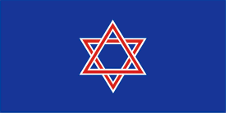
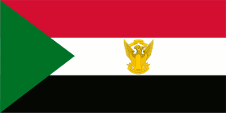


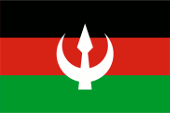





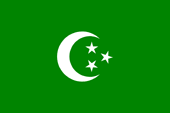
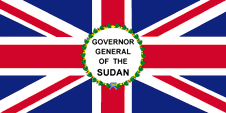
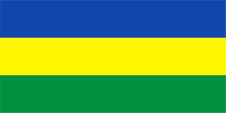







![]()
